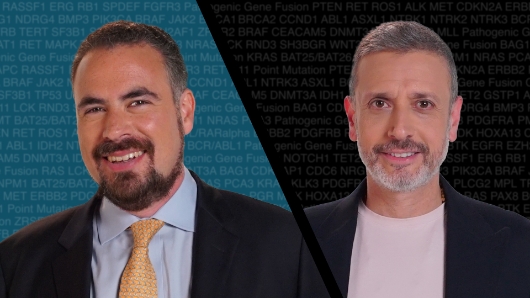Stay Informed


INCOMPLETE KNOWLEDGE HAS CONSEQUENCES
Detecting
pathogenic gene fusions
in cancer is critical for patients1-3A gene made by joining parts of 2 different genes that may lead to cancer.
Sources: National Cancer Institute. Accessed February 17, 2023. https://www.cancer.gov/publications/dictionaries/cancer-terms/def/fusion-gene. National Cancer Institute. Accessed February 17, 2023. https://www.cancer.gov/publications/dictionaries/cancer-terms/def/driver-mutation
The Promise of
Precision Oncology
Precision Oncology
The management of cancer has been revolutionized by technology that potentially enables the genomic profiling of patients' malignancies.4
DISCOVER THE
PRECISION APPROACH
PRECISION APPROACH
The Problem of
Pathogenic Gene Fusions
Pathogenic Gene Fusions
Pathogenic gene fusions, including NRG1, can be strong oncogenic drivers.1,5
EXPLORE PATHOGENIC
GENE FUSIONS
GENE FUSIONS
The Potential of
RNA-Based NGS
RNA-Based NGS
RNA-based NGS tests can improve detection of genomic alterations, including pathogenic gene fusions such as NRG1.6,7
SEE THE RNA-BASED
NGS DIFFERENCE
NGS DIFFERENCE

Explore Helpful Resources
- Watch our Expert Video series
- Download a slide presentation
- View 1-page overviews
- Review patient education materials on precision oncology
View our resources

NGS, next-generation sequencing; NRG1, neuregulin 1; NRG1+, neuregulin 1 fusion positive.
References: 1. Gao Q, Liang W-W, Foltz SM, et al. Driver fusions and their implications in the development and treatment of human cancers. Cell Rep. 2018;23(1):227-238.e3. doi:10.1016/j.celrep.2018.03.050 2. Chang JC, Offin M, Falcon C, et al. Comprehensive molecular and clinicopathologic analysis of 200 pulmonary invasive mucinous adenocarcinomas identifies distinct characteristics of molecular subtypes. Clin Cancer Res. 2021;27(14):4066-4076. doi:10.1158/1078-0432.CCR-21-0423 3. Cobain EF, Wu Y-M, Vats P, et al. Assessment of clinical benefit of integrative genomic profiling in advanced solid tumors. JAMA Oncol. 2021;7(4):525-533. doi:10.1001/jamaoncol.2020.7987 4. Schwartzberg L, Kim ES, Liu D, Schrag D. Precision oncology: who, how, what, when, and when not? Am Soc Clin Oncol Educ Book. 2017;37:160-169. doi:10.1200/EDBK_174176 5. Nikanjam M, Okamura R, Barkauskas DA, Kurzrock R. Targeting fusions for improved outcomes in oncology treatment. Cancer. 2020;126(6):1315-1321. doi:10.1002/cncr.32649 6. Drilon A, Duruisseaux M, Han J-Y, et al. Clinicopathologic features and response to therapy of NRG1 fusion–driven lung cancers: the eNRGy1 Global Multicenter Registry. J Clin Oncol. 2021;39(25):2791-2802. doi:10.1200/JCO.20.03307 7. Benayed R, Offin M, Mullaney K, et al. High yield of RNA sequencing for targetable kinase fusions in lung adenocarcinomas with no mitogenic driver alteration detected by DNA sequencing and low tumor mutation burden. Clin Cancer Res. 2019;25(15):4712-4722. doi:10.1158/1078-0432.CCR-19-0225
